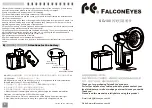
- 64 -
H.264 -
A standard for video compression, also known as MPEG-4 Part 10.
HTML (Hypertext Markup Language) -
HTML is the set of "markup" symbols or codes inserted in a file intended for display in web browser. The markup tells the browser
how to display the page's words and images for the user.
HTTP (Hypertext Transfer Protocol) -
HTTP is the set of rules for exchanging files (text, graphic images, sound, video, and other multimedia files) on the web. The HTTP
protocol runs on top of the TCP/IP suite of protocols.
Hub -
A (network) hub is used to connect multiple devices to the network. The hub transmits all data to all devices connected to it,
whereas a switch will only transmit the data to the device it is specifically intended for.
IEEE 802.11 -
A family of standards for wireless LANs. The 802.11 standard supports 1 or 2 Mbit/s transmission on the 2.4 GHz band. IEEE
802.11b specifies an 11 Mbit/s data rate on the 2.4 GHz band, while 802.11a allows up to 54 Mbit/s on the 5 GHz band.
Image compression -
Image compression minimizes the file size (in bytes) of an image. Two of the most common compressed image formats are JPEG
and GIF.
Interlacing -
Interlaced video is video captured at 50 pictures (known as fields) per second, of which every 2 consecutive fields (at half height)
are then combined into 1 frame. Interlacing was developed many years ago for the analog TV world and is still used widely today.
It provides good results when viewing motion in standard TV pictures, although there is always some degree of distortion in the
image.
To view interlaced video on e.g. a computer monitor, the video must first be de-interlaced, to produce progressive video, which
consists of complete images, one after the other, at 25 frames per second. See also Progressive scan.
IP (Internet Protocol) -
The Internet Protocol is a method transmitting data over a network. Data to be sent is divided into individual and completely
independent "packets." Each computer (or host) on the Internet has at least one address that uniquely identifies it from all others,
and each data packet contains both the sender's address and the receiver's address.
The Internet Protocol ensures that the data packets all arrive at the intended address. As IP is a connectionless protocol, which
means that there is no established connection between the communication end-points, packets can be sent via different routes
and do not need to arrive at the destination in the correct order.
Once the data packets have arrived at the correct destination, another protocol - Transmission Control Protocol (TCP) - puts them
in the right order. See also TCP.
IP Address -
An IP address is simply an address on an IP network used by a computer/device connected to that network. IP addresses allow all
the connected computers/devices to find each other and to pass data back and forth.
To avoid conflicts, each IP address on any given network must be unique. An IP address can be assigned as fixed, so that it does
not change, or it can be assigned dynamically (and automatically) by DHCP.
An IP address consists of four groups (or quads) of decimal digits separated by periods, e.g. 130.5.5.25. Different parts of the
address represent different things. Some part will represent the network number or address, and some other part will represent
the local machine address. See also IP (Internet Protocol).
JPEG (Joint Photographic Experts Group) -
Together with the GIF file format, JPEG is an image file type commonly used on the web. A JPEG image is a bitmap, and usually has
the file suffix '.jpg' or ".jpeg." When creating a JPEG image, it is possible to configure the level of compression to use. As the
lowest compression (i.e. the highest quality) results in the largest file, there is a trade-off between image quality and file size.
kbit/s (kilobits per second) - A measure of the bit rate, i.e. the rate at which bits are passing a given point. See also Bit rate.
LAN (Local Area Network) -
A LAN is a group of computers and associated devices that typically share common resources within a limited geographical area.
LED -
A light-emitting diode (LED) is a semiconductor device that emits visible light when an electric current passes through it. LEDs are
widely used as indicator lights on electronic devices. products commonly have LEDs for network, power and status.






































